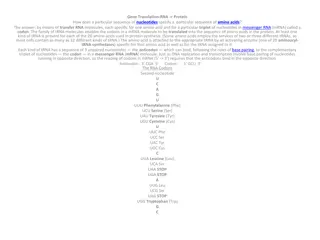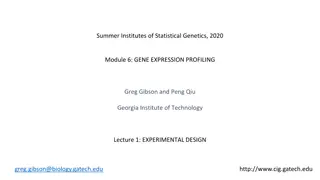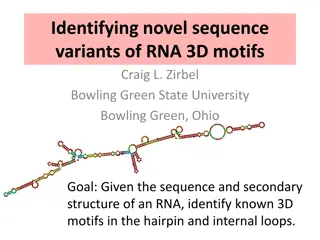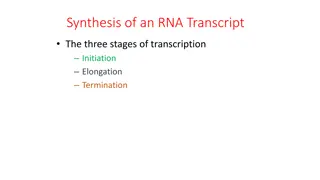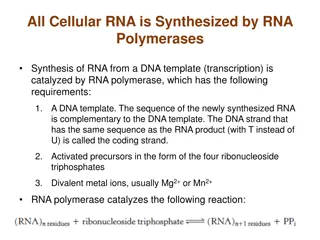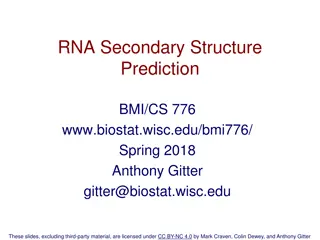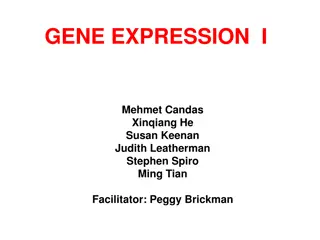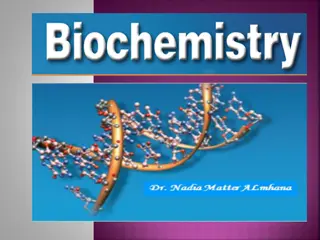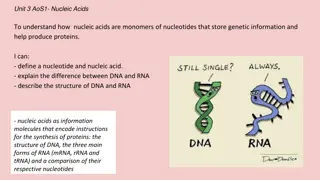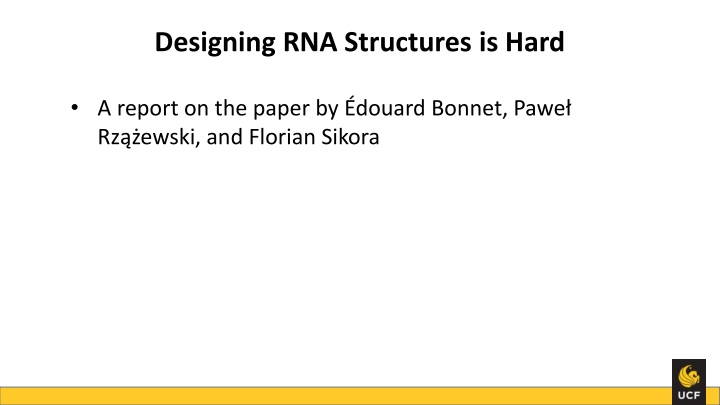
RNA Structure Design Challenges and Solutions
"Explore the complexity of designing RNA structures, the importance of secondary structures, and real-world applications in pharmaceutical research and synthetic biology. Learn about stem-loop structures, minimum free energy configurations, and the NP-completeness of RNA design problems."
Download Presentation

Please find below an Image/Link to download the presentation.
The content on the website is provided AS IS for your information and personal use only. It may not be sold, licensed, or shared on other websites without obtaining consent from the author. If you encounter any issues during the download, it is possible that the publisher has removed the file from their server.
You are allowed to download the files provided on this website for personal or commercial use, subject to the condition that they are used lawfully. All files are the property of their respective owners.
The content on the website is provided AS IS for your information and personal use only. It may not be sold, licensed, or shared on other websites without obtaining consent from the author.
E N D
Presentation Transcript
Designing RNA Structures is Hard A report on the paper by douard Bonnet, Pawe Rz ewski, and Florian Sikora
RNA Secondary Structure Design Secondary structure is important in the biological function of the molecule Solving the problem has real world applications: Pharmaceutical research Biochemistry Synthetic biology RNA nanostructures
RNA Structures RNA is made up of 4 nucleotides, labeled A, U, C, and G The primary structure of an RNA molecule is just a string over the alphabet {A, U, C, G} each element is a base Nucleotides can bind together: A with U, C with G in the Watson-Crick energy model Each binding reduces the free energy of the molecule The secondary structure of a molecule is the set of positional pair bindings
RNA Structures This structure is called a stem loop In a pseudo-knot-free structure, no stem contains part of a stem from another stem loop A minimum free energy (MFE) structure is one with the maximal number of bases paired (each pair is worth -1 energy) Sequences want to fold into an MFE configuration
RNA Structures The RNA-DESIGN problem Given a secondary structure, fill in the bases The solution cannot fold into any other structure with more bound pairs RNA-DESIGN-EXTENSION (RDE): we are given some fixed bases in the sequence Thesis: RNA-DESIGN-EXTENSION is NP-Complete
Robustness of Proof Uses Watson-Crick energy model (simplest) Other models are not uniform, more complex Prove hardness independently of energy model Ignore pseudo-knots Again, proving hardness in the easier case Reductions structure maps well to stem loops This is realistic, stem loops are a basic RNA building block
RNA-DESIGN-EXTENSION is in NP The inverse problem is RNA-FOLDING Given an RNA sequence, compute its MFE folding Can be solved with DP in polynomial time We can use RNA-FOLDING as an oracle to verify solutions to RNA- DESIGN-EXTENSION Having such an oracle means that RNA-DESIGN-EXTENSION is in NP
Proving RDE is NP-Complete Reduce from E3-SAT Each clause contains 3 distinct variables Known NP-Hard if each variable is used up to 4 times Map SAT instance onto a string representation of RDE Label the string representation with bases Show that the base sequence labels are a solution to the RDE instance iff the SAT instance is satisfiable
Representing Secondary Structures A structure a well-parenthesized expression with dots (((..)(..))) () s represent a base pair, . represents an unpaired base A sequence is a string of the same length from {1,2,3,4} 1=A, 2=C, 3=G, 4=U so proper pairs sum to 5 Sequence w corresponds to structure S if proper pairs match Sequence is a design if it can t fold into anything with more pairs A partial sequenceis a sequence with some ? s (unassigned) A partial sequence w is a design extension if the ? s can be filled in to turn it into a design.
Building the RDE instance: variables Start with a E3-SAT instance with n variable and m clauses Define t := n^2 and y := (n+3m)t Note t= (n^2), y= (n^3); y >> t >> n A variable gadget V<Xi> is: Where ( s are labeled 1, ) s are labeled 4, and . s are labeled 2 if the variable is true, else 3 The parentheses are the arch of the variable
Building the RDE instance: clauses Let a clause Cj contain three literals la, lb, lc; a < b < c la is the same gadget as V<Xa> lb and lc are V<Xb>, V<Xc> with jy parentheses pairs remove The clause is Define t := n^2 and y := (n+3m)t Note t= (n^2), y= (n^3); y >> t >> n A variable gadget V<Xi> is: The jy+q parentheses are the arch of the clause The outer jy parentheses are the first arch layer The inner q parentheses are the second arch layer
Building the RDE instance The entire instance is clauses interleaved with variables such that every clause is between the corresponding V<Xb> and V<Xc> gadgets
SAT unsatisfiable -> no design extension Black lines are by given construction, red lines are a re-matching by removing some parentheses If clause is unsatisfiable, then it is possible to rematch to a better structure This implies the originally constructed structure is NOT a design extension
SAT satisfiable -> design extension This direction is too gory for full details Given a structure S with a satisfiable SAT instance, assume There is a better structure S for the corresponding sequence w Assume wlog that S actually is the maximal matching By an argument of counting matching parts of S , can prove that there exists S which matches even MORE bases in w But this is a contradiction, so S cannot exist Therefore S itself must be the maximal matching and is a design extension We have proven SAT satisfiable iff the corresponding sequence is a design extension, thus RDE is NP-Hard We showed earlier than RDE is in NP, thus RDE is NP-Complete
Algorithmic Consequences Taking advantage of the structures in the proof leads to a faster algorithm Na ve: ? (4?) Using insights from the proof, can prune search space 3 2???(1), where s is the number of unlabeled elements in the input structure RNA-DESIGN is known to be in P for saturated structures Using DP based on ideas from the proof, RDE is also tractable on saturated structures There are many other tree-structured problems in computer science This gadget mapping may have uses elsewhere ???(1), where n is the length of the input structure


